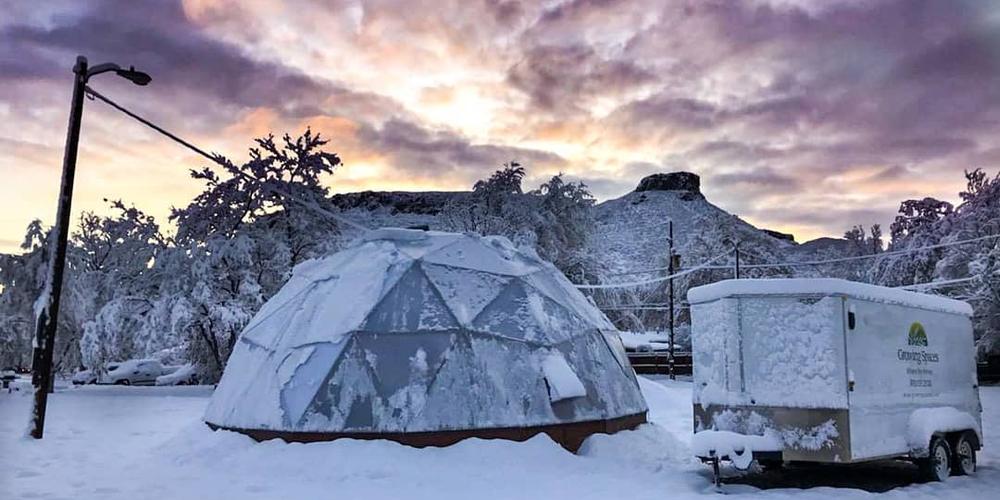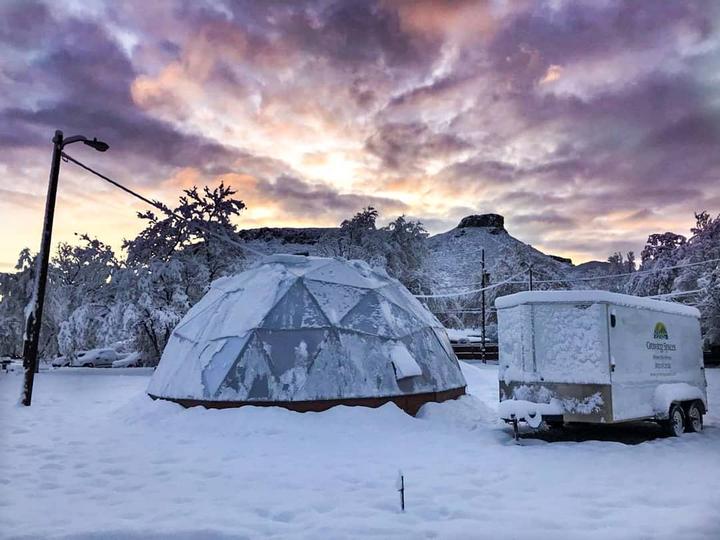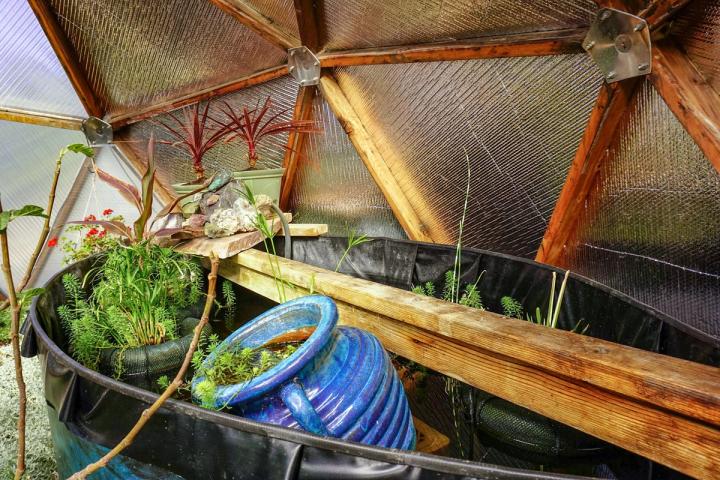
Preparing your Greenhouse for Winter
Use our super-secret checklist to ensure a thriving winter garden in your Growing Dome Greenhouse

A warm getaway spot is a necessity for gardeners in states where winters consist of low temperatures or heavy snowfall. Your Growing Dome is just that. The perfect winter garden getaway.
1. Do you need Supplemental Heat in your winter garden?
Heating Your Growing Dome In Winter Falls Into Three Main Levels Of Heating
- First Level: No heating.
- Second Level: Heating if the temperature gets into the single digits outside.
- Third Level: Never letting the Growing Dome freeze. You can calculate exactly how much heat is required to reach your desired temperature by using our “Heat Loss Spreadsheet“.
To decide what option is right for you, you need to consider two significant factors. A. What is the lowest temperature you will see outside of the dome? As the temps drop outside, the span between the outdoor and indoor temperatures will increase. To give you specifics, when temperatures are in the -20’s F (-29 C), the inside temps stay in the upper teens (15 to 19 F and -7 to -9 C) in an unheated Growing Dome. A couple of cloudy days with no sun and bitter cold with outdoor temperatures in the -20’s F can be very challenging indeed. At Growing Spaces®, we heat our Growing Domes in the winter when the temperature dips into the single digits. We hope to encourage growth throughout the winter, maintain winter produce for our staff, and present an inspiring environment for our customers to see. Many people in Pagosa Springs choose to only heat their dome when necessary. For instance, Udgar, our former owner, has only heated his 22′ Growing Dome for one week in 15 years. That was when temperatures were in the -20s for almost a week! B. Will you be growing frost-hardy plants or plants that do not thrive in lower temperatures? With plants that can handle the cooler temperatures, you should never have to heat your dome. Even with -19 F outside, cold-hardy veggies and herbs can survive, and the plant tissue can remain undamaged. Still, you will not see growth during these periods. Keep in mind that if the plants haven’t “hardened off” (i.e., accustomed to the cold temperatures), they are vulnerable to a sudden early old snap. On the other hand, if you would like to continue your growth of frost-sensitive plants, including citrus, tomatoes, and subtropical varieties of shrubs, you will NEED to provide some supplemental heat to your dome. If you are having a hard time deciding whether or not to heat your greenhouse, we recommend this more in-depth article.

What heaters do you recommend?
For smaller domes or if you have an emergency temperature drop, we recommend a Mr. Heater Big Buddy With three settings of 4,000, 9,000 and 18,000 BTU with the capacity to heat up to 450 square feet for up to 108 hours on a 20-lb. propane tank. If you are looking for an electric option, a simple radiator heater will be helpful! For bigger domes, domes growing tropical plants in a non-tropical environment, or someone who wants a fully automatic hands free heater, we HIGHLY recommend the Bio- Green Electric heater. We love this heater because it can be synced up with your phone and will turn on automatically to be sure your dome does not drop below a set temperature.
2. Have you closed your vents?
For the most part, our custom-cut vents will open and close automatically based on temperature. In the winter, however, it might be necessary to manually shut all of your vents to prevent any unwanted heat loss. For more information about winterizing your Growing Dome and other general maintenance procedures please visit growingdomecare.com, select your Dome size and scroll to the “maintenance” section. This information is for dome owners only and is password protected.
If you have solar or electric fans in your Growing Dome, similar to the vents the louvers will stay closed when it is cold. But if you would like to add insulation to the outside, simply cut a piece of blue board or similar insulation slightly bigger than the inside of the hood and press-fit it underneath the hood. Make sure you turn the fan off using the switch on the top of the fan.
3. Don’t forget about your pond!
Think of your water tank as the “Power Pack” of your Growing Dome. The pond acts as a thermal battery bank in our greenhouse kits that was mathematically sized to ensure the maximum output you need to heat your dome. If the pond is not full, the battery bank cannot properly charge. The tank needs to be kept topped off to within 2-3” of the underside of crossbar or, in the case of the circular tank, the top of the tank wall.

What are you doing in your dome?
Are you using a heater that is even better than the ones listed in this article? Do you have tips for fellow dome owners? I would love to hear them. In the meantime, connect with our inner circle of dome owners and ask winter gardening questions to any of our dome owners in our private facebook group. There have already been a few great conversations on this topic, so check them out!
Share This
I studied marketing at Eastern Illinois University and have been working as the Marketing Director at Growing Spaces since May 2019. What I love most about my job is getting to tell the stories of our customers in our featured dome articles. It’s all about connecting through storytelling, and it’s pretty cool to see all the different ways people use our greenhouses.
Subscribe to Our Newsletter
Join our community to stay up to date

Featured Categories
Downloads

Please Subscribe to Our Newsletter! :-)
Please Join our community to stay up to date :-)

